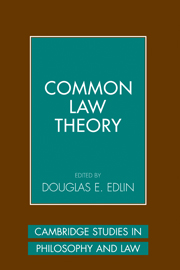Book contents
8 - The Myth of the Common Law Constitution
Published online by Cambridge University Press: 17 September 2009
Summary
Introduction
The relationship between the common law and statute law is a subject of debate. The controversy goes deeper than questions of interpretation, such as – given the doctrine of legislative supremacy over the common law – why, how, and to what extent the meaning of a statute can legitimately be governed by common law principles. The answers to those questions depend partly on more basic issues concerning the legal foundations of the two bodies of law, and their respective status. The orthodox view is that because Parliament can enact statutes that override any part of the common law, statute law is superior to common law. But according to an increasingly popular theory, Britain's “unwritten” constitution consists of common law principles, and therefore Parliament's authority to enact statutes derives from the common law. As Trevor Allan puts it, “the common law is prior to legislative supremacy, which it defines and regulates.” This theory has become so popular that even the British government has endorsed it. When the Attorney-General Lord Goldsmith was asked in Parliament what was the government's understanding of “the legal sources from which the legislative powers of Parliament are derived,” he replied, “The source of the legislative powers is the common law.”
This theory threatens to invert the relationship between statute law and common law as traditionally understood.
- Type
- Chapter
- Information
- Common Law Theory , pp. 204 - 236Publisher: Cambridge University PressPrint publication year: 2007
- 2
- Cited by

